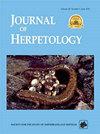Spatial Variation of False Map Turtle (Graptemys pseudogeographica) Bacterial Microbiota in the Lower Missouri River, United States
IF 0.8
4区 生物学
Q3 ZOOLOGY
引用次数: 0
Abstract
Abstract. Turtle populations around the world are continually confronted with changing environments that affect their ecology and conservation status. Among freshwater turtles, population dynamics are thought to be mediated by complex yet often cryptic causes. One recent direction of focus in addressing these causes is the turtle-associated microbiota. In turtles, the gut-associated microbiota is of exceptional interest due to its continual association with host species under changing conditions. Diet-based fluctuations and changes in microbial diversity may correspond to varying external environments at both the individual and population level. Environmental responses are of particular interest due to the anthropogenic changes that may underlie them. Pollutants, disruption of climatic patterns, and habitat fragmentation all have the potential to affect turtle-associated microbiota and subsequent population and species conservation. To better understand potential human-induced changes, the diversity of turtle-associated microbiota over local spatial gradients must be better understood. We examined microbial community α- and β-diversity among 30 adult False Map Turtles (Graptemys pseudogeographica) at three sites within the lower Missouri River, United States. Our results indicate significant microbial community centroid differences among sites (β-diversity), which are likely mediated by various local environmental factors. Such factors will have to be carefully considered in any future attribution of anthropogenic determinants on turtle-associated microbiota as it relates to turtle population dynamics.美国密苏里河下游假地图龟细菌微生物群的空间变异
摘要世界各地的海龟种群不断面临着不断变化的环境,这些环境影响了它们的生态和保护状况。在淡水龟中,种群动态被认为是由复杂但往往神秘的原因介导的。解决这些原因的一个最新关注方向是海龟相关的微生物群。在海龟身上,肠道相关微生物群因其在不断变化的条件下与宿主物种的持续联系而备受关注。基于饮食的微生物多样性波动和变化可能与个体和群体层面的不同外部环境相对应。环境反应特别令人感兴趣,因为其背后可能存在人为变化。污染物、气候模式的破坏和栖息地的破碎化都有可能影响海龟相关的微生物群以及随后的种群和物种保护。为了更好地了解人类引起的潜在变化,必须更好地了解海龟相关微生物群在局部空间梯度上的多样性。我们在美国密苏里河下游的三个地点检测了30只成年假地图龟(Graptemys pseudographica)的微生物群落α-和β-多样性。我们的研究结果表明,不同地点的微生物群落质心存在显著差异(β多样性),这可能是由各种当地环境因素介导的。在未来将人为决定因素归因于海龟相关微生物群时,必须仔细考虑这些因素,因为这与海龟种群动态有关。
本文章由计算机程序翻译,如有差异,请以英文原文为准。
求助全文
约1分钟内获得全文
求助全文
来源期刊

Journal of Herpetology
生物-动物学
CiteScore
1.60
自引率
0.00%
发文量
45
审稿时长
6 months
期刊介绍:
The Journal of Herpetology accepts manuscripts on all aspects on the biology of amphibians and reptiles including their behavior, conservation, ecology, morphology, physiology, and systematics, as well as herpetological education. We encourage authors to submit manuscripts that are data-driven and rigorous tests of hypotheses, or provide thorough descriptions of novel taxa (living or fossil). Topics may address theoretical issues in a thoughtful, quantitative way. Reviews and policy papers that provide new insight on the herpetological sciences are also welcome, but they must be more than simple literature reviews. These papers must have a central focus that propose a new argument for understanding a concept or a new approach for answering a question or solving a problem. Focus sections that combine papers on related topics are normally determined by the Editors. Publication in the Long-Term Perspectives section is by invitation only. Papers on captive breeding, new techniques or sampling methods, anecdotal or isolated natural history observations, geographic range extensions, and essays should be submitted to our sister journal, Herpetological Review.
 求助内容:
求助内容: 应助结果提醒方式:
应助结果提醒方式:


